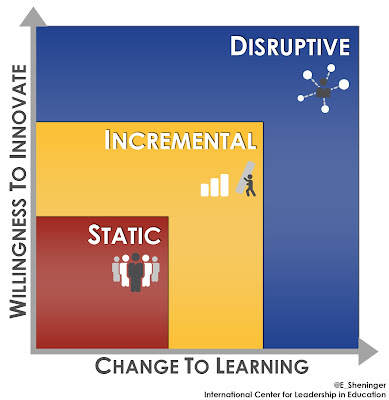We can learn many lessons from the past about change and disruptive leadership as certain organizations have embraced innovative ideas while changing the way in which they learn. Let’s take a walk down memory lane to see firsthand some powerful examples of disruptive innovation in action. Remember the days when many of us had a Blockbuster video card? If you didn’t have one you couldn’t rent a VHS tape of your favorite movie. If you did, the joy of watching the latest released movie was often squashed upon our arrival to the store as all the copies were quickly rented out. This didn’t change much when we saw the shift from VHS to DVD. So where is Blockbuster today?
Many of you know the answer to this question already and know that Netflix caused the demise of Blockbuster. Netflix was willing to innovate and change the way they learned. No brick and mortar stores, DVD’s by mail, and eventually streaming video. Blockbuster never really knew what hit them until it was too late. The innovative ideas embraced and employed by Netflix were much more consumer friendly. They also aligned nicely with the technological changes that were occurring. The stubbornness and shortsightedness of Blockbuster along with their unwillingness to move away from business as usual resulted in their ultimate demise.
Let’s look at another example. How many of us had a Blackberry as our first smartphone? I sure did and many members of my Personal Learning Network (PLN) still make fun of me for it as I held on a bit longer than most. Well, the story of Blackberry ended just about the same way as Blockbuster. Apple and Steve Jobs disrupted the smartphone business with the iPhone. Not only did the iPhone decimate Blackberry and forever knock it off the pedestal as the gold standard device, but it also sparked the smartphone wars. Virtually every touchscreen smartphone device today has come to us thanks to the iPhone. This is another example of a willingness to innovate resulting in a fundamental change to learning.
Here is one final example that is unfolding right before our eyes. The taxicab industry has been steadfast in their opposition to change. Any attempts to innovate now are futile as Uber seized on an industry that was not very consumer friendly. Uber owns no physical cars, yet is now valued at around 68 billion dollars. Anyone can get a ride using a consumer-friendly app to hail a ride for a fraction of the cost of a cab. In some cities you can even order food, helicopters, and jets. Don't think for a minute that Uber is waiting around for the next disrupter to come along and eradicate their business model. They truly understand the nature of disruptive innovation and change and are committed to being ahead of the curve. They are doing so by investing in driverless cars. Their commitment to embracing innovative ideas and relentless pursuit of learning will keep them relevant for a long time.
There are powerful lessons schools can learn from the above stories of disruptive innovation. In many ways I see similarities between schools and our education system to Blockbuster, Blackberry, and the taxicab industry. Even though there has been incremental change resulting in some isolated pockets of excellence in schools across the world, system change has been hard to come by. By employing disruptive strategies we can begin the process of creating a more relevant learning culture for our students. If we don't, history has already provided a glimpse as to what might happen.
“Innovation, in an educational context, is creating, implementing, and sustaining transformative ideas that instill awe to improve learning.”
Disruptive innovation compels educators to go against the flow, challenge the status quo, take on the resistance, and shift our thinking in a more growth-oriented way. Disruptive leadership will lead to disruptive innovation. If we hang on to the same type of thinking we will continue to get the same old results…or worse. This is why digital leadership is so important in a time of rapid change. There is time to go down the path less traveled and create systems of excellence that will be embraced by our learners and in turn better prepare them for their future. Think differently. Learn differently. Disrupt the system as we know it by embracing a business as unusual model. Let’s create a new normal.

You need to be a member of School Leadership 2.0 to add comments!
Join School Leadership 2.0